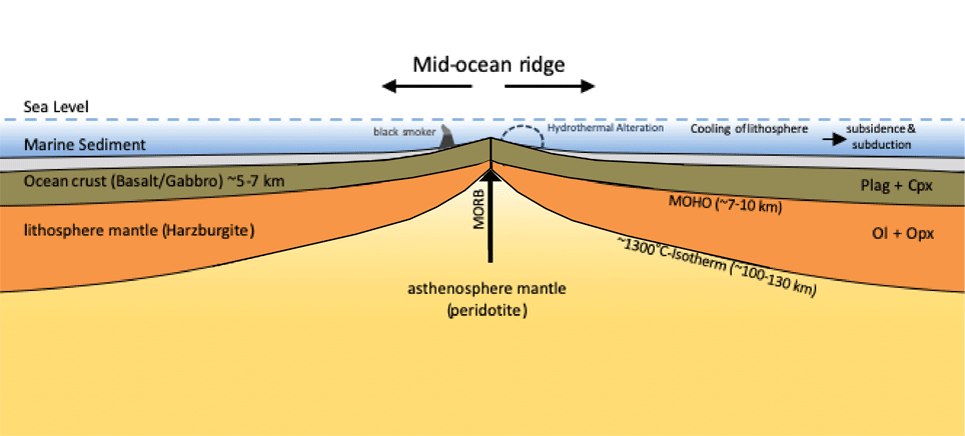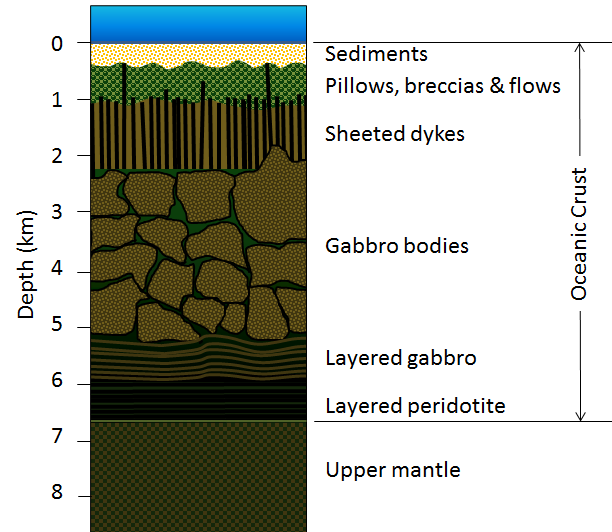Have you ever wondered what lies beneath the vast expanse of the ocean? The ocean floor is a world of mystery and wonder, with secrets hidden beneath its depths. One of the most fascinating aspects of this hidden world is how new ocean crust is continually formed. But how does this happen? The answer lies in the constant dance of Earth’s tectonic plates, a process that has shaped our planet for billions of years. This process of adding crust to the ocean floor is fundamental to understanding the dynamic nature of our world, and it’s more complex than you might think.

Image: oceanwildlifelist.blogspot.com
As someone who has always been fascinated by the Earth’s processes, I find myself constantly drawn to the wonders of plate tectonics. The fact that our planet is continually reshaping itself, with new landmasses being born and old ones slowly disappearing, fills me with awe. The process of adding crust to the ocean floor is a powerful demonstration of this dynamic, and it’s one that plays a critical role in shaping Earth’s varied landscapes.
Dissecting the Processes: Seafloor Spreading and Subduction
The ocean floor is constantly being renewed through a process known as seafloor spreading. This process takes place at mid-ocean ridges, underwater mountain ranges that form long, winding chains along the ocean floor. Imagine a giant conveyor belt of rock, moving slowly outward from the ridge. Molten rock, or magma, rises from Earth’s mantle and erupts at the ridge, solidifying into new oceanic crust. This new crust is constantly pushed away from the ridge as more magma rises and solidifies.
While seafloor spreading creates new crust, another process, subduction, recycles old crust back into Earth’s mantle. This occurs when two tectonic plates collide, with one denser plate sliding beneath the other. The descending plate, often older and denser oceanic crust, melts as it plunges into the mantle. This molten material can then rise to the surface to form volcanoes.
Seafloor Spreading: The Builder of Our Oceans
Seafloor spreading is the primary process responsible for adding crust to the ocean floor. It governs the rate at which new oceanic crust is created, and it directly influences the size and shape of the ocean basins. It’s a continuous process, driven by the movement of tectonic plates that reshapes the Earth’s surface over millions of years.
The rate of seafloor spreading varies significantly at different mid-ocean ridges. Fast-spreading ridges, like the East Pacific Rise, create new crust at a rate of several centimeters per year. On the other hand, slow-spreading ridges, such as the Mid-Atlantic Ridge, create crust at a much slower pace.
Subduction: The Recycler of Our Planet
While seafloor spreading constantly adds new crust, subduction acts as a balancing force, recycling old crust back into Earth’s interior. This process is essential for maintaining Earth’s dynamic equilibrium, preventing our planet from growing indefinitely. Subduction plays a crucial role in shaping continents, creating mountain ranges, and fueling volcanic activity.
Subduction zones are also associated with significant seismic activity. As the descending plate grinds against the overriding plate, tremendous stress builds up, resulting in earthquakes. These earthquakes can be some of the most powerful on Earth, causing widespread devastation.

Image: ecampusontario.pressbooks.pub
The Latest Developments in Plate Tectonics
The study of plate tectonics is a constantly evolving field. Researchers are continually using advanced technologies, such as GPS and seismology, to monitor the movement of tectonic plates and understand the complexities of the processes involved. New findings are constantly reshaping our understanding of how these processes work and their impact on Earth’s history.
Recent studies have revealed that the rate of seafloor spreading and subduction can fluctuate, influenced by various factors such as mantle plumes, mantle convection, and the interaction between different tectonic plates. These fluctuations can affect the rate at which new crust is added and old crust is recycled, ultimately contributing to the dynamic nature of our planet.
Tips and Expert Advice for Understanding Plate Tectonics
For those fascinated by the dynamics of Earth’s crust, here are some tips to enhance your understanding of plate tectonics:
- Visualize the process: Use online resources like interactive maps and animations to visualize the movement of tectonic plates and the processes of seafloor spreading and subduction.
- Investigate local geology: Look at the geological features in your area and try to understand how they were formed through plate tectonic processes. For example, a mountain range could be a result of a collision between two tectonic plates.
- Follow scientific updates: Stay updated with the latest research and discoveries in the field of plate tectonics through websites like the National Geographic or the USGS (United States Geological Survey).
- Explore further: Consider reading books by renowned scientists in the field of geology and plate tectonics.
By engaging with these resources and actively seeking answers to your questions, you can unlock a deeper understanding of the fascinating world of plate tectonics.
Frequently Asked Questions
Q: What evidence supports the theory of plate tectonics?
A: There is a wealth of geological evidence supports the theory of plate tectonics, including the distribution of fossils, the shape of continents, the existence of mid-ocean ridges, and the patterns of magnetic stripes on the ocean floor.
Q: Is seafloor spreading faster than subduction?
A: While seafloor spreading adds new crust, subduction recycles old crust at a similar rate, keeping the overall size of Earth’s surface relatively stable.
Q: How do plate tectonics impact our lives?
A: Plate tectonics directly influences our lives through natural hazards, such as earthquakes and volcanic eruptions. Furthermore, the movement of tectonic plates shapes the distribution of resources, affects climate patterns, and plays a crucial role in the evolution of life on Earth.
Which Process Adds More Crust To The Ocean Floor
Conclusion:
So, which process adds more crust to the ocean floor? It’s a tie! Seafloor spreading creates new crust, while subduction recycles old crust at roughly the same rate. Understanding these processes is essential for appreciating the dynamic nature of our planet, and the interplay between them shapes earth’s landscapes and influences our environment in profound ways.
Are you interested in learning more about plate tectonics? Let us know in the comments below – we’d love to hear your thoughts and engage in further exploration of this fascinating topic.





